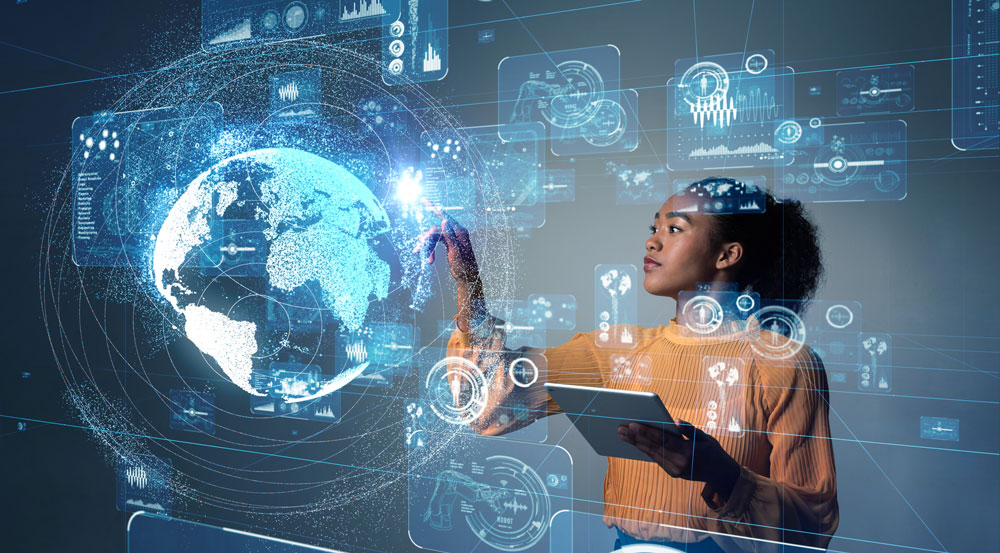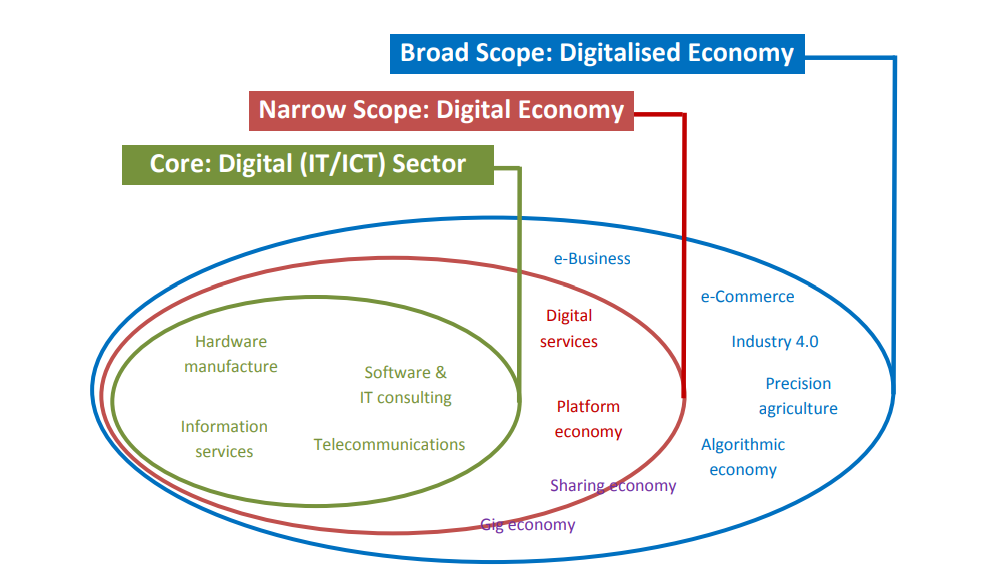First coined in the book The Digital Economy: Promise and Peril in the Age of Networked Intelligence (1995) by Don Tapscott, its content and definition continue to evolve alongside technological advancements.
In the beginning, the digital economy was called the Internet economy, or the web economy due to its reliance on internet connectivity. Later, researchers and business leaders agree that the digital economy is more advanced and complex than the internet economy. Later, it engages gig labour, more intangibles while changing the way a business is run and social business relationships.
The digital economy also reflects the move from the third industrial revolution to the fourth industrial revolution. The third industrial revolution, alternatively called the digital revolution refers to the changes that occurred in the late 20th century with the transition from analog electronic and mechanical devices to digital technologies.

Definition
Over the years, organisations, authors, researchers tried to define digital marketing but their definitions soon are not complete. Below is a result of my short study among the most cited research in recent 10 years.
In Defining, Conceptualising and Measuring the Digital Economy research by Rumana Bukh and Richard Heekse (2017), two authors listed the definitions of the digital economy over two decades by different organisations, authors, from 1996 to 2016. By comparing and following its improvements and expansion, they finalised that digital economy is a part of economic output derived solely or primarily from digital technologies with a business model based on digital goods or services”. Nowadays, it covers business processes and activities via internet environment via information technologies, digital platforms that convert into successful transactions.
Components of digital economy
Within decades of diffusion, it has been developed in the multi sides i.e vertically and horizontally. As it keeps growing fast and more detailed, and structured, any definitions and divisions works at the time of defining.

Firstly, in an effort to conceptualising digital economy, Bukh, R. and Heekse, H. (2017) showed the above illustration with its core of IT/ICT sector. They serve as foundation to facilitate digital services which supports and platform economy that support quicker and more secure digital transaction. This conceptualisation is conincedent with what England goverment released UK Digital Strategy on October 2022. Thanks to solid foundation, new digital business models and new digital services emerge to replace the conventional business process such as TV, newspaper, radio marketing into advent of Google – solely digtal; streamline online one like then platform trading tangible goods like Amazon, Ebay, Alibaba. Later, they engages more social resources, gig labors into the market, with the and later Airbnb and Uber reaching the blurred edge. And its scope continues expanding, shaping the fouth digital evolution.
Secondly, with the measurement approach, US Bureau of the Census or Census Bureau (2001) and Bureau of Economic Analysis (2022) initially set up their measuring methodology, definitions and framework consistently and continuously expanded since 1999. I appreciate this fundamental approach that simplify measuring and understanding of digital economy.
According to the Census Bureau report version 2001, there are three primary components to measure the US digital economy. They asserted that “the definitions are internationally broad to provide an inclusive framework for planning statistical measures, and to allow flexibility to incorporate continuing changes in the digital economy.” (US Census, 2001). Consequently, over the years, in another New and Revised Statistics of the U.S. Digital Economy, 2005–2021 by the Bureau of Economic Analysis 2022 under U.S. Department of Commerce, they continue expanding the coverage of its estimates. Besides the conventional division by activity, as below, they also measure by sectors. They are respectively:
Infrastructure
is the share of total economic infrastructure used to support electronic business processes and conduct electronic commerce. It includes hardware, software, telecommunication networks, support services, and human capital used in electronic business and commerce.
Priced digital services
are any process that a business organisation conducts over computer-mediated networks internally and externally. Over the years, I observe a modification of terms in BEA report 2022, compared to the 2021 report by US Census. They adjusted from electronic business to priced digital services with an intent to remove all free-of-charge services that are adopted by enterprises.
It comprises all one of the following paid online processes: access to vendors’ products/catalogs, ordering from vendors, electronic payment to vendors, vendor-managed inventory, use of electronic marketplaces and online auctions. Internal processes include email capabilities, automated employee services, training, information sharing, video conferencing, recruiting and telecommuting.
E-commerce
is the value of goods and services solved over computer-mediated networks. It counts any completed transaction to transfer the ownership or rights to use goods or services, not payment. They generally measure B2B and B2C e-commerce from the seller’s perspective,
Federal nondefense digital services
In the report 2022 version, BEA added federal nondefense digital services that represents the annual budget for services that are directly related to supporting the digital economy.
[to be continued…]
Source:
Ruma Bukht & Richard Heeks, 2017. Defining, Conceptualising and Measuring the Digital Economy, Centre for Development Informatics Global Development Institute, SEED
Thomas L. Mesenbourg, 2001, Measuring the Digital Economy, U.S. Bureau of the Census
Dr. Reinhard Geissbauer, Jesper Vedso and Stefan Schrauf, 2016, Industry 4.0: Building the digital enterprise, PwC
Department for Digital, Culture, Media & Sport, UK, 2022, Policy Paper: UK Digital Strategy
Kevin Barefoot, Dave Curtis, William Jolliff, Jessica R. Nicholson, Robert Omohundro, (2018), Defining and Measuring the Digital Economy, Bureau of Economic Analysis, U.S Department of Commerce
UNCTAD, 2021, Digital Economy Report